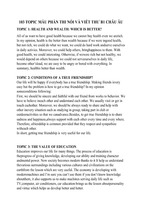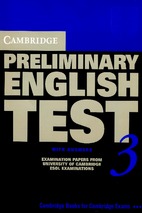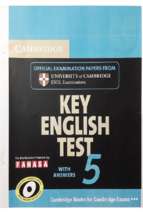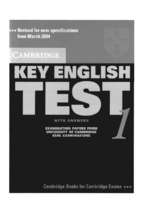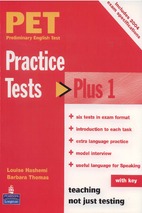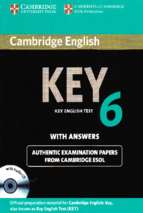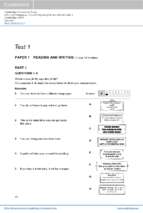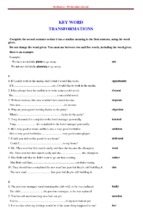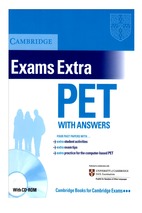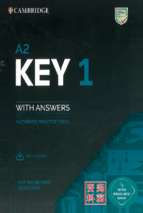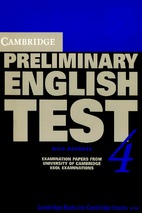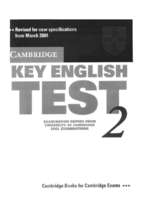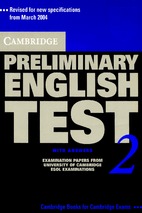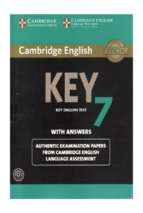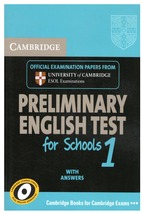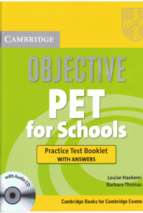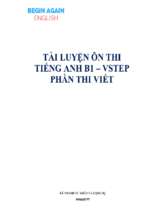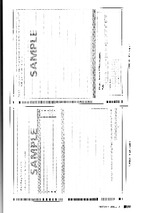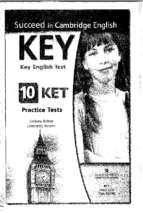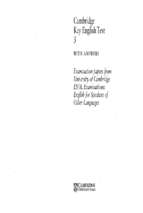A2
Elementary
Teacher’s Pack
Adrian Doff & Mark Lloyd
With Rachel Thake & Cathy Brabben
Acknowledgements
Adrian Doff would like to thank Karen Momber and Keith
Sands at Cambridge University Press for overseeing the
project and for their invaluable help and support throughout
the development of this course. He would also like to thank
his editor, Liam Guyton, for his commitment and hard work
and his help in bringing the book into its final form.
He would like to thank Dr Astrid Krake and Donna
Liersch at the Volkshochschule München for giving him an
opportunity to teach there and try out new ideas.
He would also like to thank Gabriella Zaharias for
consistently supporting and encouraging him during the
writing of this book.
Mark Lloyd would like to thank the teachers and staff of IH
Bath/WELS Bath for their suggestions and ever-constructive
criticism, as well as all those students who have, knowingly
or otherwise, acted as enthusiastic guinea pigs. Above all,
however, he would like to thank Rosa – for her patience and
for doing far more than her fair share of the parental duties –
and Gabriela, for her smiles and giggles!
Rachel Thake and Cathy Brabben would like to thank their
colleagues and students in the ESOL department at Thames
Valley University, Reading Campus, for their help and
support with Writing Essentials. Special thanks go to Mary
Langshaw, Angela Buckingham, Sue Laker and Sue Allan.
The authors and publishers are grateful to:
Text design and page make-up: Stephanie White at
Kamae Design
Video content: all the team at Phaebus Media Group
Illustrations by Kathy Baxendale, Nigel Dobbyn, Mark
Duffin, Paul Moran, Julian Mosedale and Sean Sims
The authors and publishers acknowledge the following
sources of copyright material and are grateful for the
permissions granted. While every effort has been made,
it has not always been possible to identify the sources of
all the material used, or to trace all copyright holders.
If any omissions are brought to our notice, we will be
happy to include the appropriate acknowledgements on
reprinting.
For the tables on the DVD-ROM and the text on pages 4 and
20 of the Teacher’s book © Common European Framework
of Reference for Languages: Learning, teaching, assessment
(2001) Council of Europe Modern Languages Division,
Strasbourg, Cambridge University Press
Contents
Introduction
The thinking behind English Unlimited�
4
How a unit is organised�
6
A detailed look at the features of English Unlimited�
11
The Self-study Pack�
16
The Teacher’s Pack�
17
Assessing your learners with English Unlimited�
18
The Common European Framework of Reference for Languages (CEF)�
20
Teaching notes
Intro unit�
21
Unit 1�
24
Unit 2�
31
Unit 3�
38
Unit 4�
45
Unit 5�
52
Unit 6�
59
Unit 7�
67
Unit 8�
75
Unit 9�
82
Unit 10�
89
Unit 11�
96
Unit 12�
103
Unit 13�
110
Unit 14�
117
Grammar reference: Answer key�
124
Writing essentials�
125
Contents 3
The thinking behind English Unlimited
The aim of English Unlimited
The aim of English Unlimited is to enable adult learners to
communicate effectively in English in real situations. To
achieve this, English Unlimited is:
1 a practical course
2 an authentic course
3 an international course
4 a flexible course
1 A practical course
Each unit of English Unlimited is designed to help learners
achieve specific communicative goals. These goals are
listed at relevant points throughout the Coursebook. For
example, you and your learners will see these goals at the
top of the first lesson in unit 10:
The CEF originated in Europe but is used increasingly
widely around the world as a guide for curriculum design
and assessment. It can be used with learners of any
nationality or first language.
What’s the level of the course?
The CEF is divided into 6 main levels, sometimes with
‘plus’ levels in between. This table shows the CEF levels
and how they relate to the Cambridge ESOL exams:
CEF levels
Cambridge exams
C2
‘Mastery’
CPE
C1
‘Operational proficiency’
CAE
‘Vantage’
FCE
‘Threshold’
PET
A2
‘Waystage’
KET
A1
‘Breakthrough’
B2+
B2
B1+
B1
A2+
English Unlimited Elementary reviews elements of A1
(Starter level), completes A2, and moves well into A2+.
All the goals are of a practical ‘can-do’ nature, chosen to
enable Elementary level learners to deal with a wide range of
situations in English. Of course, a substantial amount of each
unit is dedicated to learning vocabulary and grammar – but
the goals come first. We’ve identified goals which we think
will be useful for Elementary level learners to work on, and
then selected vocabulary and grammar to help them do this.
Where exactly do the goals come from?
The goals for the course have been taken from the Common
European Framework of Reference for Languages (CEF),
and adapted and supplemented according to our research into
the needs of Elementary level learners.
The goals in the Coursebook are based on the CEF goals
but have been reworded to make them less ‘technical’ and
more motivating and accessible for learners and teachers.
What is the CEF?
The CEF uses ‘can-do’ statements to describe the abilities
of learners of English (or any other language) at different
levels. The focus is on how to do things in the language,
rather than on abstract knowledge of the language itself. For
example, here are some CEF goals which describe learners’
speaking abilities at the end of Elementary:
Can handle very short social exchanges but is rarely
able to understand enough to keep conversation going
of his/her own accord, though he/she can be made to
understand if the speaker will take the trouble.
l Can use simple, everyday polite forms of greeting and
address.
l Can make and respond to invitations, suggestions and
apologies.
l Can say what he/she likes and dislikes.
l
4 Introduction
2 An authentic course
Because it is based on practical goals, English Unlimited
teaches authentic language – that is, the kind of language
which is really used by native speakers and proficient nonnative speakers of English in everyday situations.
An important tool for identifying useful language to include
in the course has been the Cambridge International
Corpus (CIC).
What is the CIC?
The CIC is an electronic collection of more than a billion
words of real text, both spoken and written, which can be
searched by computer to discover the most common words,
expressions and structures of the language, and the kinds of
situations in which they are used.
How has it been used in the course?
The CIC has been used throughout English Unlimited to
ensure that, as far as possible given the level of the course,
learners are taught the most frequent and useful words
and expressions for meeting their communicative goals.
The CIC has also been used in the preparation of grammar
sections to identify realistic contexts for presenting
particular structures. For example, corpus research suggests
that a common use of the past simple is ‘checking something
was done’ (unit 4), while the present progressive is often
used for the function of ‘saying you’re busy’ (unit 7).
A further use of the CIC is in the Keyword sections which
appear in every unit. Each Keyword section focuses on
one or more of the most frequently-used words in English,
and teaches its most common meanings, as well as useful
expressions based around it.
How else is English Unlimited an authentic course?
In addition to being informed by the CIC, English
Unlimited contains a large amount of unscripted audio
and video material, recorded using non-actors, both native
and non-native speakers. Many other listening texts have
been scripted from recordings of real conversations.
What are the benefits for learners of using ‘authentic’
listening material?
Listening to spontaneous, unscripted speech is the best way
to prepare learners for the experience of understanding
and communicating in English in the real world. Our
observations have shown not only that Elementary level
learners are capable of following spontaneous speech, but
that authentic recordings are more motivating and engaging
for learners in general.
3 An international course
In what ways is English Unlimited ‘international’?
Firstly, English Unlimited is an inclusive course, catering
to learners of different backgrounds from all around the
world. We have taken care to select topics, texts and tasks
which will appeal to a broad range of learners. We’ve tried
to avoid topics which learners may find uncomfortable, or
simply uninteresting, and we don’t assume a knowledge
of a celebrity culture, but focus instead on more universal
themes, accessible to all.
English is most often used nowadays between non-native
speakers from different places. How does the course take
this into account?
A second strand to the ‘internationalism’ of the course is
that it includes features which will help learners become
more effective communicators in international contexts.
In every odd-numbered unit there is an Across cultures
section which focuses on a particular topic of cultural interest.
The aim of these sections is to increase learners’ awareness
of how the values and assumptions of the people who they
communicate with in English might differ from their own.
Learners who have this awareness will be more sensitive and
effective communicators in international environments.
Listening sections use recordings of speakers with a
range of accents, in order to familiarise learners with the
experience of hearing both native and non-native speakers
from a wide variety of places. Regardless of accents, care
has been taken to ensure that recordings are of appropriate
speed and clarity for learners at this level, and that they
are error-free. All non-native speakers are competent users
of English and should provide learners with strong and
motivating role models to help them progress and achieve
greater confidence in English.
For the purposes of language production, taught grammar,
vocabulary and pronunciation follow a British English
model, but by exposing learners to a wide range of accents
and models, we are helping to enhance their ability to use
English in real international contexts.
4 A flexible course
The next four pages show how a typical unit of English
Unlimited is organised.
As you’ll see, the first five pages are connected to each other
and make up the ‘core’ of the unit. After that, there is the
Explore section, two pages of activities which have a topical
or linguistic link to the unit, but which can be used separately.
On the last page of each unit is the Look again section,
comprising review and extension activities, which can be
done by learners either in the classroom or for homework.
This means that English Unlimited can be adapted not only
for lessons of different lengths, but also for shorter and
longer courses. For example, just using the ‘core’ of each
unit would be suitable for a course of about 50 hours, while
using all the material, including the Explore and Look again
sections, would give a course length of 80 or 90 hours.
The flexibility of English Unlimited is further enhanced
by an extensive range of supplementary materials. These
include extra grammar practice at the back of the
coursebook, the Teacher’s DVD-ROM containing four
printable worksheets for each unit of the Coursebook,
Achievement and Progress tests, and the Self-study Pack,
which offers more than 50 hours of additional language and
skills practice material in the Workbook and on the Selfstudy DVD-ROM.
In the rest of this introduction you’ll find:
a plan showing how a unit is organised pages 6 to 10
more detailed notes on the different sections of the
units pages 11 to 15
l information about the other components of the course
pages 16 to 19
l more detailed information about the CEF page 20
l
l
We hope that you and your learners will enjoy using
English Unlimited!
Alex Tilbury
David Rea
Leslie Anne Hendra
Theresa Clementson
Introduction 5
How a unit is organised
The course consists of a shorter ‘Intro’ unit
and 14 main units. Each main unit has 8 pages.
The first two pages are a single lesson
with goals based on the CEF. You can
of course spread the material over
more than one lesson if you want.
about 90 minutes
Lessons include vocabulary and/or
grammar, as well as practice in reading,
listening, speaking and writing. Lessons
always finish with a communicative
speaking (or occasionally writing) task.
See pp11–13 for details of language and
skills sections.
6
Introduction
The next two pages are another
lesson with goals based on the CEF.
about 90 minutes
An illustrated Vocabulary reference is
provided at the back of the Coursebook to
give extra support for key groups of words.
There is also a Grammar
reference and extra grammar
practice for every unit at the back
of the Coursebook.
Every unit has a focus on
pronunciation. See p12 for details.
Introduction
7
The last four pages of a unit will
take about 45 minutes each.
The fifth page is the heart of the unit, the Target activity.
Learners prepare for and carry out an extended task
which is designed to combine and activate language
taught in earlier lessons in the unit. See p13 for details.
Target activities review goals from
the earlier lessons of the unit.
Model recordings are used
to demonstrate the task.
Task Vocabulary sections
provide learners with useful
language for the task.
Learners are encouraged to take
time to prepare ideas and language.
Target activities have a clear outcome.
8
Introduction
The Explore section is made up of activities which extend and broaden the
topics, language and skills taught in the core part of each unit. On the first page
is the Keyword, then Across cultures or Independent learning in alternate
units. On the second page is either Explore writing or Explore speaking.
Each Keyword section focuses on a
common English word, teaching and
practising the main meanings and useful
expressions. See p13 for details.
Odd-numbered units have Across cultures
sections which give learners the chance to
think about and discuss how cultures differ
around the world, and to reflect on their
own culture. See p13 for details.
Odd-numbered units have Explore
speaking pages dedicated to developing
learners’ speaking skills and strategies.
See p14 for details.
Even-numbered units have Independent
learning pages which develop learners’
independent study skills. See p14 for details.
Even-numbered units have Explore writing
pages which enable learners to write a range
of different text types. See p14 for details.
Introduction
9
The last page of each unit, Look again, is a series of
short classroom activities for reviewing and extending
the language from the unit. See p15 for details.
Review activities include vocabulary
and grammar from the unit.
Spelling and sounds activities
help learners make connections
between English spellings and
how to pronounce them.
Notice activities draw out further
useful language from the unit’s
reading or listening texts.
At the end of each unit
is a Self-assessment for
learners to complete.
Can you remember? activities review
a language point from the previous unit.
10
Introduction
A detailed look at the features
of English Unlimited
Vocabulary
English Unlimited provides learners with a wide variety of
vocabulary, chosen to meet each unit’s communicative goals.
In most units, there are three or four vocabulary sections in
the first two lessons and Target activity, and vocabulary is
also presented and practised in Keyword sections, on Explore
writing pages, and on Explore speaking pages.
Vocabulary includes:
l words like passport, engineer.
l collocations like full-time job, fresh air.
l stems like I’m in the middle of … .
l fixed expressions like I don’t know exactly.
The focus on longer items as well as single words will
enable learners to express themselves more fluently,
naturally and effectively.
The course provides a balance of:
l very frequent vocabulary, selected and checked using
the Cambridge International Corpus (CIC).
l topical and functional items which learners need in
order to achieve particular goals. For example, food and
drink words are not especially frequent statistically, but
are obviously necessary for the fulfilment of goals such
as ‘talk about shopping and food’ and ‘order a meal’.
Taught vocabulary is generally drawn from texts which
learners have already read or listened to as part of a skills
section of a lesson. In other words, vocabulary is placed in
clear contexts which help learners work out what it means,
and how it’s used.
Vocabulary reference
At the back of the Coursebook is an illustrated Vocabulary
reference which lists larger sets of words on key topics like
places (airport, bank, bridge, etc.), food (chicken, rice,
broccoli, etc.) and jobs (accountant, architect, builder,
etc.). Learners are encouraged to make active use of the
Vocabulary reference at relevant points in lessons to acquire
key language for extension and personalisation activities:
Grammar
Each unit of the course teaches the grammar essential to
achieving the communicative goals.
The points of the grammar syllabus have been selected
and placed in particular units to help learners meet these
particular goals. For example, the present progressive
is focused on in unit 7 because it is often used to make
excuses, such as: I’m sorry, I’m not feeling well or I’m just
making dinner. Similarly, conditional sentences are taught
in unit 12 as they are very useful for giving advice: If
you’ve got a very bad cold, don’t go to work.
Grammar points have been corpus-checked to find the
most frequent and natural forms for each function and
context. For example, in unit 4, the past simple is taught in
the context of a business trip. We found that a very frequent
function of the past simple is ‘checking progress / checking
things have been done’, and this is the way in which the
past simple is introduced on p37.
Before focusing on grammar explicitly, learners are first
exposed to grammar in context through reading and
listening texts. Then meaning and form are highlighted
using a ‘guided discovery’ approach which actively
involves learners in finding out about the grammar for
themselves while also providing plentiful support and
opportunities for you to intervene and assist:
Thorough controlled practice is provided to check learners’
understanding of the language and provide initial practice,
while maintaining and developing the topic of the lesson:
Lessons end with a speaking task (or, occasionally, a writing
task) which gives learners the chance to use the language of
the lesson, including the grammar, in freer practice.
Grammar reference
In each grammar section, you’ll see a label like this ...
… which directs learners to a Grammar reference section at
the end of the book, accompanied by extra practice exercises.
Each Grammar reference section sets out the meaning,
form and pronunciation of the point in question, using
simple language and a range of examples:
The extra practice exercises can either be done in class as
the need arises, or set as homework.
Introduction
11
Pronunciation
Listening
There is one pronunciation section in each unit.
These sections have both receptive and productive aims:
l to help learners understand natural spoken English.
l to build confidence by isolating and practising specific,
manageable features of spoken English.
l to help learners speak more intelligibly.
Note that, although native-speaker voices are used to model
features of pronunciation, the primary goal of these sections
is intelligibility and not (necessarily) achieving a nativelike accent.
Pronunciation sections address areas which will be useful
for all Elementary level learners to work on, regardless of
their first language: syllables, word stress, sentence stress,
the schwa sound and basic consonant–vowel linking.
Each pronunciation section is based around a short extract
drawn from a listening sequence. Learners are encouraged
to notice a language feature and then practise it:
There is at least one major listening section in the first two
lessons of each unit, and other listening activities occur
frequently in sections such as Target activity, Across
cultures, Independent learning and Explore speaking.
A wide range of recordings, both authentic and scripted,
is used, including monologues, topical conversations
between friends and colleagues, conversations in service
situations, phone calls and interviews.
Authentic recordings are unscripted and feature
both native and non-native speakers from a variety of
backgrounds. These provide exposure to a range of accents
and to features of real spoken English, such as vague
language and hesitation devices.
Scripted recordings are based on real-world recordings
and corpus data to guarantee the inclusion of natural
expressions and features of English. They are often used to
contextualise functional language, such as expressions for
shopping or ordering a meal.
Texts are exploited using a range of tasks designed to
develop specific listening skills, build confidence and
prepare learners for less graded authentic texts. For
example, this sequence includes:
l gist listening (5)
Key pronunciation areas are touched upon two or three
times during the course rather than being ‘one-offs’,
thereby building learners’ familiarity and confidence.
Interest is maintained by slightly increasing the level of
challenge on each occasion. For example, the activity
above from unit 7 asks learners to notice words with schwa
/ə/ sounds in a conversation and practise producing them,
while the activity below, from unit 8, requires learners to
identify which words contain the schwa sound:
l
l
l
In addition to each pronunciation section, you’ll often see
the symbol in vocabulary and grammar sections. This
symbol indicates points in the lesson when it would be
useful to use the audio CD to drill the pronunciation of new
language.
The Spelling and sounds activity in the Look again
section of each unit helps learners to pronounce words in
English by recognising spelling patterns. This feature is
described in more detail on p15.
Learners can also practise the individual sounds they have
problems with, using the Self-study DVD-ROM. The same
material can be found on the Teacher’s DVD-ROM, so
you can offer guidance to learners who need help with
particular sounds.
12
Introduction
listening for specific information (6a)
use of the recording script for learners to check answers
for themselves (6b)
an opportunity for learners to respond to the recording in
a natural way (7).
Reading
Each unit has at least one major reading section in the first
two lessons. Smaller reading texts are used in some Target
activities and can be found in Across cultures and Explore
writing sections.
A wide range of text-types is used, both printed and
electronic: newspaper, magazine and online articles, web
postings, advertisements, brochures, programmes and
personal correspondence.
Reading texts:
l are drawn from sources around the world in order to
appeal to as many learners as possible.
l are authentic, or based on authentic texts, ensuring that
learners are exposed to natural language and preparing
them for the experience of reading outside the classroom.
l recycle known language in order to build learners’
confidence in reading.
l are slightly above learners’ productive language level, so
that learners have opportunities to notice new language.
l provide a context for vocabulary and grammar which is
to be taught.
Texts are exploited using a range of tasks appropriate for the
level and text-type. For example, this sequence includes:
l a prediction task (1a) followed by reading for gist (1b)
Keyword
The most frequent words in English tend to have a
number of different meanings and to occur in a range of
patterns and expressions. Each unit of the course has a selfcontained Keyword section which focuses on one of these
words, clarifies its key meanings and useful expressions as
identified by corpus research, and practises them.
The meanings and expressions of the keyword are often
illustrated using examples from the current unit and
previous units:
This is followed by controlled and freer practice:
a task which requires learners to read for details (2a)
l a jigsaw reading task which provides an information
gap (2a) and motivates learners to speak (2b)
l an opportunity for a natural, personal response to the
text (3).
For further reading practice, the Self-study Pack contains
seven Explore Reading sections, each of which focuses on
a different real-life reading scenario.
l
Target activity
The target activity is an extended speaking task, which
recycles some or all of the goals, vocabulary and
grammar of the previous two lessons. It is the conclusion
of the first five topically-linked pages of the unit.
As part of the task preparation, the Target activity also
provides further listening or reading skills development,
and further language input. Target activity pages have
three sections.
Task listening and Task reading sections have three
objectives: they provide a model for the task which students
do later on, they provide a context for the vocabulary which
is presented afterwards, and they provide further receptive
skills development:
The Task vocabulary is drawn from the listening or reading
above, and focuses on useful language for the task to follow:
In the Task section, students are given the chance to think
about the ideas and the language they want to use before
they begin, meaning that they will be able to focus on
accuracy as well as fluency when they do the task itself:
You can support your learners during task preparation by
encouraging them to look back at the relevant vocabulary
and grammar sections from the preceding lessons.
Across cultures
More and more people around the world are learning English
in order to live, work, study and travel in other countries. The
increasingly global nature of business, travel, education and
personal relations in today’s world means that intercultural
awareness is an area of growing interest and need for learners
everywhere. The Common European Framework of Reference
for Languages (CEF) identifies intercultural awareness as a
key sociolinguistic competence (chapter 5.1.1–3). Learners
who are interculturally competent are more sensitive and
effective communicators in international situations.
To this end, the Across cultures sections are intended to
help learners to:
l communicate better with people from a range of cultural
backgrounds.
l be more aware of the kinds of differences and similarities
that can exist both between and within cultures.
l reflect on aspects of their own and other cultures in an
objective, non-judgmental way.
l contribute to an exchange of ideas about cultures by
drawing on their own observations and experiences.
The course has seven Across cultures sections in oddnumbered units (alternating with Independent learning).
Each looks at a particular topic from an intercultural
perspective:
Unit
1
3
5
7
9
11
13
Greetings
Conversation ‘dos and don’ts’
Personal space
Workplaces
Transport culture
Saying sorry
Your experiences
Introduction
13
Across cultures sections are structured like a mini-lesson.
They typically include a brief lead-in, a listening or reading
text for further skills development, and some language
input to support learners in a final speaking stage where
they talk about their own and other cultures.
Listening stages often use authentic recordings of people
talking about their own countries and cultures. These are
intended to engage learners’ interest and promote discussion,
rather than representing the only ‘truth’ about a given culture.
Indeed, learners with experience of the same culture are
encouraged to agree, disagree and add further information.
Independent learning
The seven Independent learning sections are in evennumbered units (alternating with Across cultures):
Unit
2
4
6
8
10
12
14
Finding information
Self-study
Using a dictionary
Reading the phonemic script 1: consonants
Reading the phonemic script 2: vowels
Learning collocations
How do you learn languages?
The aim of these sections is to help learners to become
more independent in their learning of English, both inside
and outside the classroom, by:
l making them aware of a variety of course and self-study
materials.
l enabling them to make better use of these materials.
l learning ways in which they can extend the learning
process outside the classroom.
Explore speaking
Explore speaking sections occur in odd-numbered units
(alternating with Explore writing).
Explore speaking is a complete, free-standing page which
aims to equip learners with skills and strategies for
improving their spoken interaction in a wide range
of situations. It addresses real-life, immediate needs of
Elementary learners, such as:
l asking people to repeat
l checking information
l taking a phone message
l starting and finishing conversations
l showing interest in a conversation
l developing a conversation
l changing topics
Each Explore speaking page includes:
l a listening text containing the target language. The
listening, which generally links to the topic of the unit as
a whole, provides a clear context for the target language.
14
Introduction
l
l
l
l
the listening script on the same page. This enables
learners to see and study the target language right away
without having to flick to the back of the book.
activities in which learners notice the target language
in different ways, such as categorising expressions
according to their function.
controlled practice exercises which build familiarity
and confidence with the target language.
a freer practice task, such as a role play, which gives
learners the chance to use the target language in a reallife situation.
Explore writing
Explore writing pages occur in even-numbered units
(alternating with Explore speaking).
This page is dedicated to improving learners’ writing skills
through a sequence of activities which build towards a
practical, purposeful writing task. As with Explore speaking,
the page will have a topical link with the rest of the unit.
Specifically, Explore writing pages will help learners to:
l write a range of short text-types appropriate to the
level, e.g. an email giving news, an invitation, an email
of apology, a note requesting something.
l understand genre-specific conventions, e.g. email
greetings, language for invitations and thank you notes,
short requests and reminders.
l develop micro-skills for writing coherent sentences
and short paragraphs, through work on areas such as
punctuation and a range of linkers.
l develop confidence in writing by planning and
discussing ideas with peers, talking about and improving
texts together, and building from shorter to longer texts.
Each page contains one or more models of the text-type
learners will produce at the end of the lesson. The sequence
of exercises will usually require learners to:
l read the model texts for meaning.
l notice specific language features in the texts.
l practise using the new language in writing.
l plan a piece of writing, e.g. learners may be asked to
generate ideas in pairs or groups, then organise their
ideas into paragraphs.
l write their own texts.
l read each other’s texts and respond where possible
(either orally or in writing).
l work to improve their own or each other’s texts.
You can of course set some of the later stages of the writing
process as homework if you prefer.
In many cases the goals for these pages refer to both
traditional and electronic media (e.g. ‘write a letter or
email of request’), meaning you can choose to ask your
learners to write either on paper or on computer, if the
facilities are available.
Look again
The Look again page is divided into two columns, Review
and Extension. Although some sections can be set as
homework, the page is intended as a series of communicative
activities for learners to do in class. The Look again page
also includes a final Self-assessment for the unit.
Review
The three Review activities will help learners to recycle
language from both the current and previous unit:
1 Vocabulary – provides further communicative practice of
a key area of functional or topical language from the unit.
2 Grammar – provides further communicative practice of
the key grammar point in the unit.
3 Can you remember? – recycles a key language focus
from the preceding unit to help students reactivate and
better retain the language.
Extension
The two Extension activities focus on useful aspects of
language, extending learners’ knowledge beyond what is
taught in the main body of the text.
4 Spelling and sounds – this section is intended to meet the
need of learners and teachers for a systematic approach to
English spelling.
It takes a ‘spelling to sounds’ approach in the belief that the
most useful guide for Elementary learners is to help them to
recognise and say words that they see written down. It looks
at such areas as consonant and vowel recognition; how to say
common consonants and vowel patterns; the effect of final ‘e’
on the pronunciation of vowels; silent letters; and consonant
doubling before endings.
Spelling and sounds will help students to:
l become aware of spelling/sound correlations, helping to
improve both spelling and pronunciation.
l learn general rules for spelling in manageable amounts.
l develop accuracy in spelling and therefore confidence in
writing.
l revise words encountered in the current and previous
units.
5 Notice – further exploits reading and listening texts from
the unit by briefly looking at and practising a useful and
regularly-occurring language feature, e.g. a set of time
expressions, the use of to for giving reasons, uses of gerunds.
Self-assessment
Each unit concludes with a Self-assessment box for learners
to complete either in class or at home. Many learners find it
useful and motivating to reflect on their progress at regular
intervals during a course of study.
For teachers, the Self-assessment will be a valuable means
of gauging learners’ perceptions of how much progress
they’ve made, and of areas they need to work on further.
Self-assessments can also be useful preparation for
one-to-one tutorials in which the learners’ and teacher’s
perceptions of progress are compared and discussed.
Introduction 15
The Self-study Pack
About the Self-study Pack
English Unlimited Elementary Self-study Pack has been
designed to offer flexibility and depth to your English
teaching, whatever the specific needs of your learners. The
Workbook and Self-study DVD-ROM provide a wide range
of language and skills practice activities to accompany each
unit of the Coursebook, so you can:
l set homework tasks based on the Coursebook lessons
l supplement your lessons with further language and skills
practice
l use authentic video activities in class, or get learners to
watch at home.
Your learners can:
l consolidate their knowledge of language and skills
taught in class
l practise and check their pronunciation
l learn and practise essential speaking skills
l create tests on specific language areas quickly and easily
l check their progress and get feedback on their level of
English and any specific areas of difficulty
l record and listen to themselves speaking in everyday
dialogues, with animated video and audio materials.
In the Workbook
English Unlimited Elementary Workbook contains:
activities which practise and extend the vocabulary and
grammar taught in the Coursebook units; further reading,
writing and listening skills practice; and numerous
opportunities in each unit for learners to personalise what
they are learning to their own interests and situations.
The first two pages of each unit consist of further
vocabulary and grammar practice activities which can
either be used in class or set for homework. Over to you
activities suggest ways for learners to personalise the
language and skills they have learnt.
Time out, in even-numbered units, offers a fun way for
learners to practise and remember vocabulary sets.
My English, in odd-numbered units, profiles learners
from around the world, offering your learners a different
perspective on learning English and encouraging them to
reflect on their own learning.
Explore reading, in even-numbered units, offers practice
in reading, understanding and responding to a range of
everyday texts, such as newspaper and magazine articles,
leaflets, programmes and web pages.
Explore writing, in odd-numbered units, gives learners
key pointers on structure and language, to enable them to
produce a wide range of written texts, such as emails, blogs,
letters and detailed instructions.
16
Introduction
The last page of each unit, DVD-ROM Extra, links up
with the authentic video on the Self-study DVD-ROM.
Learners have the chance to watch and listen to real people
from around the world, talking about topics connected to
the unit. These can be used in class or by learners on their
own at home or in the school multi-media room.
On the Self-study DVD-ROM
The English Unlimited Elementary Self-study DVD-ROM
offers your learners over 300 interactive activities which
they can use to practise and consolidate what they’ve
learned in class, while providing a number of easy ways to
check their progress at every step of the course.
Just click on the icon for each unit and the learners will
find fun and easy-to-use activities, from picture matching
and drag-and-drop category exercises to opportunities for
learners to record themselves and play back the result to
check against an audio recording.
Each unit’s activities practise and extend the vocabulary,
grammar, pronunciation and Keyword areas focused on
in the Coursebook. Learners can also generate tests quickly
and easily, using the QuickCheck question bank. They
can choose which units they want to test and how many
questions you want the test to consist of, and QuickCheck
will randomly select from the 700 questions in the bank.
Learners can also keep track of their progress as they
work through the course. The Progress page shows them
which scored exercises they have attempted and how
they’ve done. Learners can see which language areas they
need to do more work on and can go back and try again.
In addition to language practice, each unit of the Selfstudy DVD-ROM also contains several Explore speaking
activities. These allow learners to listen to everyday
conversations, noticing key speaking skills such as
using conversation fillers or showing interest, and then
incorporate these techniques into their own spoken English.
In most language courses, it is rare for learners to get the
chance to listen to themselves in conversation, but if there
is a microphone available, this can be done easily using the
animated video clips on the DVD-ROM. Learners watch
and listen to the clips, take a closer look at the language
used, and then have the opportunity to record themselves in
the conversations and play it back to hear how they sound.
On the Self-study DVD-ROM, you will also find the DVDROM Extra video, described above, which can be used
in or outside class, using the last page of each unit of the
Workbook, or just watching them to get extra exposure to
real language.
The Teacher’s Pack
We understand that no two teachers or classes are alike, and
that the role of a Teacher’s Pack accompanying a language
course is to cater for as diverse a range of pedagogical
needs as possible. The materials in this Teacher’s Pack
serve to enhance the flexibility of English Unlimited to
meet the needs of teachers who:
l are teaching courses of different lengths
l want to supplement the Coursebook materials
l have different class sizes and types
l are teaching in different parts of the world
l are addressing different assessment needs
l want to use DVD materials in the classroom
English Unlimited Elementary Teacher’s Pack offers a stepby-step guide to teaching from the Coursebook, more
than 60 photocopiable activity worksheets to extend
and enrich your lessons and a complete testing suite. The
Teacher’s Pack consists of the Teacher’s Book and the
Teacher’s DVD-ROM.
In the Teacher’s Book
Teacher’s notes
In the Teacher’s Book, there are more than 100 pages of
teacher’s notes (pp21–123) to accompany the Coursebook
material. These notes are a comprehensive and easy-tofollow guide to using the English Unlimited Elementary
Coursebook, and have been written with a broad range of
class-types and teaching styles in mind.
Each unit’s notes take you smoothly through the different
stages of the Coursebook lessons. Answers are clearly
highlighted, and the Individual, Pair and Group work
symbols show at a glance what interaction is suggested for
each stage.
On every page, there are instructions for alternative
activities, clearly boxed, to offer greater variety and
interest. There are also suggestions throughout for adapting
activities to stronger and weaker classes, multilingual and
monolingual classes, younger learners, and to large and
small class sizes.
On the Teacher’s DVD-ROM
Photocopiable activities
There are 45 photocopiable activity worksheets on the
Teacher’s DVD-ROM (three for each unit) ready to print
out and use straight away. These offer extra vocabulary,
grammar and pronunciation practice, extra reading and
writing work, role plays and games which further activate
the language that learners have been introduced to in
the Coursebook, and build their fluency, confidence and
communication skills.
Each activity is accompanied by a page of clear, step-bystep instructions, with answer keys and extra teaching ideas.
At the end of each unit of the Teacher’s notes, there is a
page to help you find the activities you need.
Writing essentials
The Writing essentials activities (described in more detail
on pp125–128) consist of 12 sets of photocopiable activity
worksheets specially designed for non-Roman alphabet
learners of English. Each activity teaches a vital writing
or reading skill, such as letter formation or recognition of
common words, and supports learners in the process of
reading and writing in a new script. These activities can be
used alongside the Coursebook and other material, or as
part of a separate course for non-Roman alphabet learners.
Progress and Achievement tests
The English Unlimited testing suite consists of 14 unit-byunit Progress Tests and 3 skills-based Achievement tests
to motivate your learners and give you and them a clear
idea of the progress that they are making. These and other
methods of assessment are discussed in detail on pp18–19.
Videos
Two DVD-ROM videos per unit from the Self-study Pack
are also included on the Teacher’s DVD-ROM, as they are
easily adaptable for use in class.
Introduction 17
Assessing your learners with
English Unlimited
There are many ways of assessing learner progress through
a language course. For this reason English Unlimited
offers a range of testing and assessment options, including
progress tests, skill-based achievement tests, assessment
using the e-Portfolio, self-assessment and continuous
assessment.
Tests on the Teacher’s DVD-ROM
There are two types of test available as PDFs on the
Teacher’s DVD-ROM: Progress and Achievement tests.
Progress tests
There is one Progress test for each of the 14 units of the
course. These assess the learners’ acquisition of language
items taught in the main Coursebook material. Each test
carries 40 marks and includes questions assessing grammar
and vocabulary items taught in the unit. These are not
intended to be ‘high stakes’ tests but rather quick checks
that will help the teacher and learner judge which language
points have been successfully acquired and understood, and
which areas individual learners or the whole class may need
to study again.
We suggest that each test should take no more than
30 minutes in the classroom. Tests can be copied and
distributed to each learner and taken in class time. The tests
are designed for quick marking with the provided Answer
Key. Teachers may choose to mark tests, or, alternatively,
learners can mark each other’s work. A mark can be given
out of 40. If particular problem areas are identified, learners
can be directed to do extra work from the Self-study Pack.
Achievement tests
There are three Achievement tests, designed to form the
basis of formal learner assessment.
l Achievement test 1 can be taken after unit 4.
l Achievement test 2 can be taken after unit 9.
l Achievement test 3 can be taken after unit 14.
These tests are based on the four skills, Reading, Listening,
Writing and Speaking.
Reading tests
Each test is based on a short text and we advise allowing no
more than 15 minutes for each test. As with the Coursebook
and Listening tests, there may be a few unfamiliar items in
the text but the tasks are graded so unknown items should
not hinder the learners’ ability to answer the five questions.
The teacher may mark the tests or it may be acceptable for
learners to mark each other’s work.
Listening tests
The audio tracks for these are found at the end of the three
Class Audio CDs. Achievement test 1 is track 57 on CD1;
Achievement Test 2 is track 57 on CD2; Achievement
Test 3 is track 62 on CD3.
18 Introduction
We suggest carrying out tests under controlled conditions
with the recording played twice. Each test should take no
longer than ten minutes. As with the Coursebook audio,
there may be a few unfamiliar language items in the
listening text but tasks are graded to the level of the learner,
so unknown items should not hinder the learners’ ability to
answer the five questions. The tests are simple and quick
to mark. They can be marked by the teacher or it may be
acceptable for learners to mark each other’s work.
Writing tests
Learners are set a writing task based on themes from
the Coursebook and the teacher assesses work using the
analytical marking scales provided. Tasks are designed
to simulate purposeful, real-life, communicative pieces
of writing. The teacher should endeavour to identify the
band the work falls in for each category. This marking
scheme can give learners a profile of the strong and weak
points of their written work, creating a virtuous circle of
improvement through the course.
If the tests are to be used under timed conditions in class,
forty minutes should be allowed for the learners to produce
their texts – planning and redrafting may be encouraged by
the teacher at the outset.
Another way is to set the tasks as assessed writing
assignments to be done as homework. In these cases, the
teacher should interpret the band scales according to the
time available and the availability of dictionaries and other
reference materials.
The option chosen will depend on your learning
environment. A timed test may help you assess learners
under equal conditions, but can be a rather artificial,
pressured environment. Written homework assignments are
less controlled, but could be a better way of encouraging
learners to work at their writing and feel satisfied with a
polished piece of written work. The Explore writing tasks
in the Coursebook and Self-study Pack may also be used
as assessed assignments and marked using the Writing
assessment scales.
Speaking tests
These are designed to be carried out by an assessor, who
may be the learners’ regular teacher, or another teacher
in the institution. Learners do the tests in pairs. The ideal
environment is for the test to take place in a separate room
from the rest of the class, who can be engaged in self-study
work while the testing is taking place. It is best if seating is
set up as a ‘round table’ if possible, rather than the teacher
facing both learners across a desk, so as not to suggest an
interrogation! Each test takes ten minutes.
The assessor should be familiar with the Speaking
assessment scales for the speaking tests before the test and
have a copy of the Mark Sheet for each learner with their
names already filled in. Screen the mark sheets from the
learners.
The assessor will need the Teacher’s Notes, which provide
a script of prompts for the test. Each test is in two parts. In
the first part (six minutes), the assessor puts the learners at
ease with warm-up questions, before asking the learners
in turn a selection of questions from the Notes, based on
themes from the Coursebook. The assessor may depart from
the script to elicit further responses, maintaining a friendly,
encouraging manner. The assessor may begin to note down
some marks based on the scales for each learner.
In part 2 (four minutes) learners are provided with prompts
for a communicative task, which they carry out between
themselves. Learners may need some encouragement, or to
have the instructions explained more than once.
During this section the teacher should withdraw eye
contact, making it clear that the learners should talk to
each other, listen closely and revise the marks from part 1,
gradually completing the grid.
The assessor should not correct learners at any point during
the test.
Filling in the mark sheets
Once all four papers of the Achievement tests have been
carried out, the teacher can provide marks for each learner.
This includes marks for the Speaking and Writing tests, and
an average mark out of five for each one; and marks out
of five for the Reading and Listening tests. This gives the
learners a snapshot of their performance in the four skills.
The learners should be encouraged to reflect on what they
found easy or difficult, and given strategies to improve
performance in different skills. The marks can be used as
the basis for course reports or formal assessment.
Self-assessment
Assessment is not just about tests. Self-assessment
encourages more reflective and focused learning. English
Unlimited offers a number of tools for learner selfassessment:
l Each unit of the Coursebook ends with a self-assessment
grid in which learners are encouraged to measure their
own progress against the unit goals, which in turn
are based on the can-do statements of the Common
European Framework of Reference for Languages.
l Progress with the activities on the Self-study DVD-ROM
can be analysed in detail on the Progress screen.
l The Self-study DVD-ROM also contains Quick Check
tests, using a bank of 700 multiple-choice questions.
Learners select which units they want to be tested on
and how long they want the test to be – new tests will be
randomly generated each time.
Using the e-Portfolio
Portfolio-based assessment is a useful tool for both selfassessment and formal assessment, particularly for teachers
seeking an alternative to traditional timed writing tests. The
e-Portfolio allows learners to:
l Assess their progress against can-do statements and
revise their assessments later in the course depending on
progress made.
Build up a personal e-Portfolio of written work
associated with the course. The learner may then select
their best work, as an alternative to tests, or at the end
of the course to be provided as a Portfolio. This may
include word-processed documents, project work and
even audio files. Some of the Explore writing tasks may
lend themselves well to portfolio work, and in some
classrooms learners may be asked to record personal
audio files based around speaking tasks in the book. The
satisfaction of producing a polished spoken text is a rare
one in a language course, but if the learner or the centre
has access to a microphone, it is relatively easy to do.
Written texts and audio in a learner’s e-Portfolio may be
assessed using the same analytical scales as the Writing and
Speaking Achievement tests.
l
Continuous assessment
Finally, some teachers and institutions may prefer to
dispense with tests and adopt a form of continuous
assessment. This can be demanding on teacher’s time
but perhaps no more so than the marking load created by
frequent formal tests. The important thing is to explain the
system to learners early in the course, and regularly show
them their marksheets to indicate how they are getting on.
How actual assessment is carried out may differ between
institutions, but here are some guidelines and ideas:
l It is possible to assess learners using the Speaking
assessment scales regularly through the course. The
Target Activities, where learners are involved in more
extended discourse, offer an opportunity for this.
l Tell learners when their speaking is being assessed and
the teacher can monitor particular groups.
l Learners should be assessed several times during the
course or they may rightly feel they were let down by
a single bad performance, even if the assessment is not
‘high stakes’.
l An atmosphere of gentle encouragement and striving
for improvement should always accompany this kind
of assessment. Some learners can get competitive
about this, which can have a negative effect on class
atmosphere and demotivate less confident learners.
l The Explore writing tasks can be used for continuous
written assessment, using the marking scales for writing.
A final word
Testing and assessment can be a vital tool for the teachers
and learners in assessing strengths and weaknesses,
building awareness and encouraging improvement. But it
can be frustrating for a learner to feel that they are being
assessed too often, at the expense of actually learning, and
whilst there are certainly learners who like being tested,
there are many others who certainly don’t!
English Unlimited aims to help learners communicate in
real-life situations, and the testing and assessment tools
provided should be used with that purpose in mind. Testing
and assessment should never take precedence over learning,
but serve as useful checks on the way to increasing
confidence, competence and fluency.
Introduction 19
The Common European Framework
of Reference for Languages (CEF)
A goals-based course
Where the goals are met
English Unlimited is a practical, goals-based course for
adult learners of English. The course goals are taken and
adapted from the language-learning goals stated in the
Common European Framework of Reference for Languages
(CEF).
The goals of the CEF are divided into a number of
scales which describe abilities in different kinds of
communication. We’ve chosen the scales which we felt
to be the most useful for adult general English learners at
Elementary level. These are:
As you’ll see in the example unit on pp6–10, goals are
given for the two lessons at the start of each unit, for the
Target activity, and on the Explore speaking and Explore
writing pages. They are also listed in the Self-assessment,
which learners do at the end of the Look again page.
Listening and reading goals are not usually given on the
page as they are addressed repeatedly throughout the
course. The CEF tables on the Teacher’s Pack DVD-ROM
show which parts of the course deal with the listening and
reading goals.
Speaking
Describing experience
Conversation
Informal discussion
Goal-oriented cooperation
Transactions to obtain goods and services
Information exchange
Turntaking
Co-operating
Asking for clarification
Writing
Creative writing
Correspondence
Notes, messages and forms
Listening
Overall listening comprehension
Understanding conversation between native speakers
Listening to announcements and instructions
Listening to audio media and recordings
Reading
Overall reading comprehension
Reading correspondence
Reading for orientation
Reading for information and argument
Reading instructions
20 Introduction
Find out more about the CEF
You can read about the CEF in detail in Common European
Framework of Reference for Languages: Learning,
teaching, assessment (2001), Council of Europe Modern
Languages Division, Strasbourg, Cambridge University
Press, ISBN 9780521005319.
- Xem thêm -


